Brief

Why are so many fast-growing, disruptive companies able to run circles around larger, slower multinationals? In most cases, it boils down to what we call the Founder’s Mentality®—a potent mix of insurgent mission, owner’s mindset and passion for the front line and customers. These companies were typically founded by bold, ambitious entrepreneurs and have internalized how to translate strategy into action. They’ve developed a deep understanding of what their customers want and know how to deliver it quickly and seamlessly.
But they also face a major challenge: If they want to sustain growth over the long term, they will have to acquire the cost advantages and market power that come with achieving scale and scope. Yet as they become larger and more complex, they encounter a number of predictable forces that tend to burden them with complexity and erode their Founder’s Mentality, the core strengths and values that powered their early growth and competitiveness.
We’ve worked with dozens of management teams confronting this issue. In formal forums with members of our Developing Market 100 initiative over the past year, we have closely examined how insurgent companies can grow and achieve the benefits of scale without taking the all-too-common default path toward slow-moving incumbency (see Figure 1). We’ve learned that this journey, which we call the Journey North, is a multiyear commitment to defining the insurgent mission succinctly, translating it into strategy and using that strategy as a blueprint for growth and professionalization. Every company is different, of course, but we’ve found the most effective leadership teams maintain their Founder’s Mentality as they grow by following six critical steps (see Figure 2).
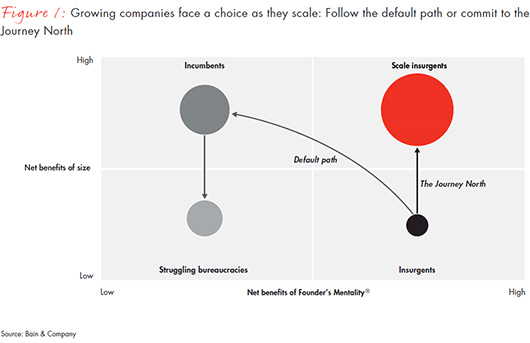
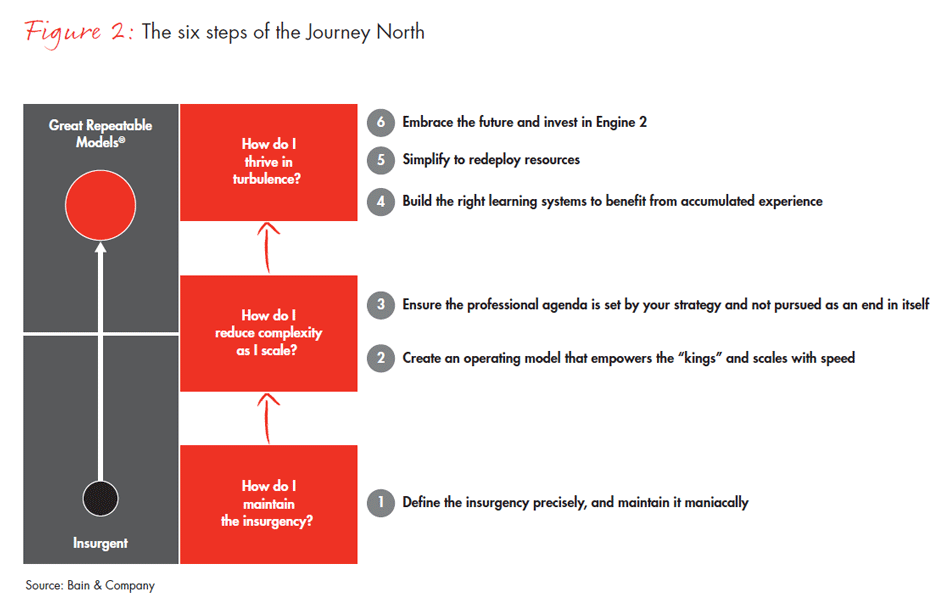
Step 1: Define the insurgency precisely, and maintain it maniacally
People who work for insurgent companies love their products. They are on a mission to redefine their industry on behalf of an underserved consumer segment. But as they grow, one of the greatest risks these companies face is that their people begin to lose touch with the insurgent mission and define themselves instead by the timeworn rules of their industry. The first part of the Journey North, then, is about how you maintain the insurgency by locking it in with the people who must deliver it.
That begins with a question: Why do we exist? As companies grow, a clear answer becomes harder and harder to find. For many who work at large incumbent companies, the only response seems to involve financial or competitive metrics—to increase shareholder returns, for instance, or to take share from a rival. Insurgents, by contrast, answer from the gut. Anyone at CavinKare, the Indian consumer products company, would say, “Whatever a rich man enjoys, the common man should be able to afford, and our job is to find a way to solve this.” For one Brazilian retailer the answer is, “To give aspiring lower-class consumers the opportunity to own furniture, ‘white goods’ and consumer electronics by helping them solve their financing needs.”
This mission must be embodied by a clearly articulated strategy everyone in the company can describe simply—a strategy designed for the front line, not the boardroom. A basic tool we use to test the degree of simplicity is called the “strategy on a hand” (see Figure 3). The thumb represents a succinct statement of the insurgent mission. The fingers outline the critical capabilities and linking processes that enable a company to deliver this strategy as a Repeatable Model®.
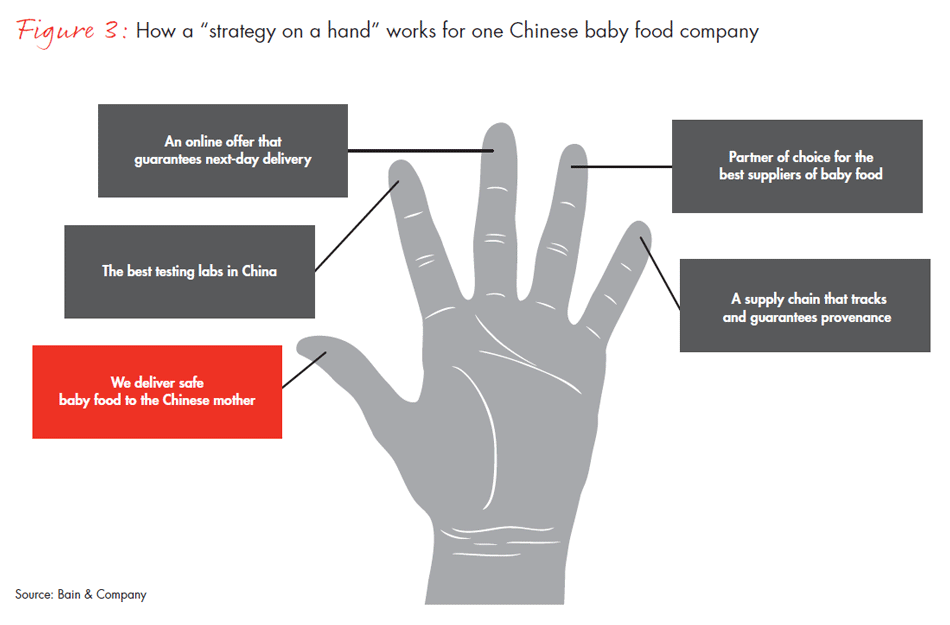
These capabilities tend to fall across what we describe as our “capability matrix,” which identifies 15 ways a company can create competitive advantage across the organization (see Figure 4). Defining the three or four in which the company must be world class helps set the right capability-building agenda.
While it is crucial to lay out the strategy so the entire organization can understand it, transforming a strategy into a repeatable model also requires recognizing and empowering the key people involved in delivering that strategy. In this context, it is important to identify those we call the “kings,” the individuals or teams within the organization most accountable for delivering the product and services that define the insurgent mission. They often occupy the front line, but not always. In most retail businesses, for instance, the king is the store manager. But for a mobile phone manufacturer, the king may be the product manager or product team—the group responsible for developing the phone that is either bought or passed over by the end user.
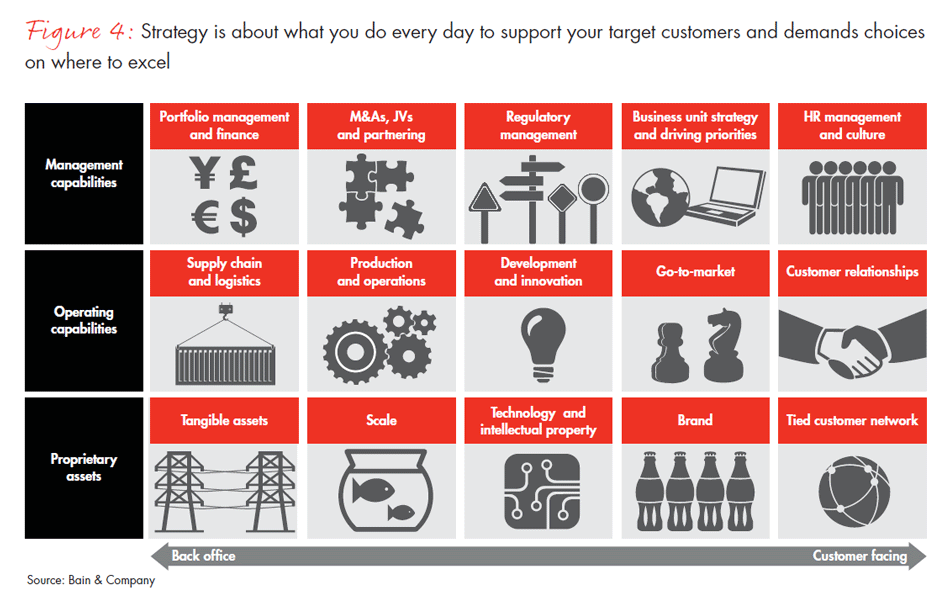
Defining and elevating the kings allows top leadership to involve these key people directly in the strategy-making process. This means bringing them together to cocreate what we call the “nonnegotiables” underlying Repeatable Models®—the practical behavioral rules and prohibitions that can be embraced by the entire organization and used to guide consistent action and shape decisions. Nonnegotiables should distill and simplify the strategy at the foundation of the company’s repeatable model by reducing it to a set of easily understood, prescriptive statements written in the kings’ own language. For a baby food retailer in China, for instance, one nonnegotiable was “Every product we send is labeled with the manufacturer’s brand and our brand—food safety is personal.” The list of nonnegotiables, what some have called a “compass,” should then form the basis of the coaching agenda for your kings.
The Journey North starts with locking in the insurgency: defining it for everyone, using it to set the capability agenda, and translating it into specific actions and behaviors that will be used to deliver strategy. Putting the kings at the center of the process from the outset ensures that the voice of both the front line and the customer will guide the company’s direction.
Dunigan O'Keeffe, a partner with Bain’s Strategy practice, reveals how companies can make the Journey North, so they can grow and achieve the benefits of scale without losing their Founder's Mentality.
Step 2: Build an operating model that scales without sacrificing speed
Insurgents are in a period of hyper growth, where organizational issues are often far more critical than closing the next sale. Too often, the sum of the organizational decisions made during this phase destroys the company’s most important strategic capability: speed.
One founder at a meeting of a dozen founder/CEOs whose fast-growing companies had been acquired by the same corporate parent highlighted why losing speed is so dangerous: “As a tiny company operating in a vast ecosystem, you have only one real competitive advantage: speed. When we start a dialogue with a customer, we know deep in our hearts we can get them exactly what they want, tailored to their specifications, faster than any of the big boys. When the scale of the corporate buyer helps speed us up, that’s a good thing. When it doesn’t slow us down, that’s also a good thing. But when your ‘value added’ slows us, that’s the kiss of death.”
Our approach to scaling without losing speed is based on leaders getting three things spectacularly right:
- First, they must create an operating model that is built for speed.
- Second, they must create an organizational model with an outward focus. This should empower the kings to better serve customers; align the “court” (those in the organization who must support the kings); and reduce “the rest” (those non-king and non-court roles that serve the bureaucracy, not the customer).
- Third, they must be clear about how they will scale the business and keep the scaling model simple.
Each of these three imperatives is a call for simplicity and clarity as you grow. They are all about defining who is accountable for what and giving these people the tools they need to succeed. But this is not simply about individual accountability. In our experience, team accountability is just as important. The best organizations focus on building teams to gang-tackle problems. They enforce a culture that fosters teaming and celebrates actions that involve more than one player.
Step 3: Use the professionalization agenda to balance heroes with systems
Insurgent companies thrive on heroics and defying the odds. But eventually they need to grow up. They have to become more professional and balanced by adding talent, capabilities and systems to bring order to the chaos of rapid growth—the unsustainable hours, the lack of control and so on. Too often, however, these professionalization efforts take on a life of their own and distract management from the critical task of finding an accelerated path to industry leadership. At worst, they destroy the company’s insurgent culture and erode its essential speed.
The problem is not professionalization per se. Rather, it is letting the professionalization agenda become an end in itself. Strategy, not a checklist, should guide decisions around which systems, processes and new capabilities are (or are not) truly supportive of the kings and their efforts to deliver the insurgent mission. In our experience, the most effective leaders use several approaches to staying on track:
- The Monday meeting. The idea here is to prioritize a weekly meeting, which will pull leaders out of their silos to make decisions together and confirm to all of them that success equates with gang-tackling problems. It also signals to the broader organization that important issues will be resolved on a timely basis, not whenever leadership gets around to it. As companies add systems and new professional managers, establishing a predictable cadence for fast conflict resolution helps enforce a culture of speed and responsiveness.
- The talent table. This is a tool we cocreated with our DM100 members that focuses your hiring on “swing values.” By this we mean it translates your strategy into an agenda of the most important initiatives the company faces in terms of creating value or avoiding value destruction. Once you’ve determined these initiatives, you can define precisely the mission-critical experience you are seeking: What does each person need to do, and therefore, what real experience am I looking for? This ensures that hiring is targeted and driven by strategy.
- The systems and capabilities table. The systems table does the same thing for capability building. After you have worked with the kings to translate your strategy into nonnegotiable actions and behaviors, you then have to work with your teams to define the capabilities and systems needed to support those nonnegotiables. This ensures the systems you build enhance the delivery of strategy instead of interfering with it (see Figure 5). Using the systems table in conjunction with the talent table will produce a long, multiyear professionalization agenda that is linked directly to your strategy. Once this is established, there’s no time to waste on lesser priorities that just add complexity.
- Effective integration. What’s critical to remember as companies add new professionals and systems is that they are there to strengthen the heroes, enabling them to reach new heights. Recruiting and integrating professionals that understand this is one of leadership’s most important and difficult jobs—and needs to be led directly by the founder or CEO. At the same time, the old guard needs to understand that the new professionals are crucial to sustainable growth. China’s Yonghui Superstores has done an outstanding job of managing this balance. The founders have been careful to recruit for cultural fit. But they are very clear that the founding team also needs to learn to let go: “Founders do a lot of things right, but we also do a lot of things wrong,” one of Yonghui’s founders told us. “Professionals can help us bring the company to the next level. They are doing some great things that we should support rather than say, ‘Things were different back in the old days.’”
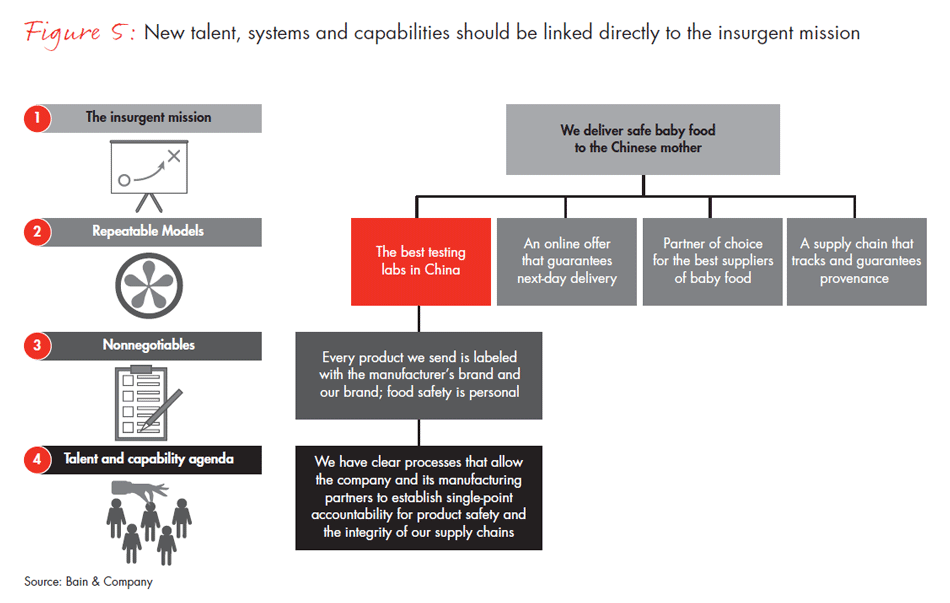
Step 4: Build the right learning systems
There is one undisputable benefit of growth, and that is learning. Accumulated experience should create a deep moat around an incumbent company that keeps insurgents at bay. But in many cases the incumbent loses the art of learning, which provides the insurgent with a unique opportunity to learn faster about the things that really matter. That starts with building feedback loops between the customer and the kings.
We recently helped a founder-led consumer technology company identify its kings—in this case, the top engineers charged with designing the latest products. One false move could break the company, yet these engineers had almost no customer feedback. They never met with customers; they never watched customers make purchase decisions. Several tried to attend a focus group run by marketing but were told they weren’t needed.
Our first recommendation was to reorient customer feedback so the product development engineers received clear, timely information on how they were doing. We also emphasized that this is a leadership issue. Leaders create learning organizations by making it clear through role modeling that everyone is responsible for listening to the customer. One department might “hold the microphone,” but it is everyone’s job to listen to what is being said.
It is also important to create a culture that rewards employees for learning from one another. A peer-to-peer learning system is crucial for constant sharing of experiences, so all can take a speedy flight down the experience curve. Too often, companies end up putting in place hub-and-spoke learning systems that discourage the sharing of experiences and best practices. At a DM100 workshop with founders and senior outside hires of an Indian company, one of the hires said, “I’ve learned more about the issues faced by my peers today than I’ve heard in the last year. We are so preoccupied with managing our ‘lanes’ that we set aside almost no time to talk and learn from each other.”
Step 5: Simplify to redeploy resources
Most large organizations believe the opposite of simple is “advanced,” not “complex.” They add additional systems and processes one after another because who would say no to something that is more advanced? Those who view simple’s opposite as complex see things differently. They question anything that threatens simplicity and empower those adept at simplifying.
Notwithstanding Steps 1–4, growth leads to complexity, and complexity is the silent killer of growth. So leaders on the Journey North must continually spring clean, “zero-basing” all they do on a regular basis to speed things up and redeploy trapped resources. The simplification agenda is, first and foremost, about retaining speed. But it is also about freeing up resources.
Companies experiencing hyper growth can’t afford to have talent and investment trapped where they aren’t serving the strategy. A growing company’s success depends on its ability to overwhelm its biggest priorities with the right talent and the right resources, on a moment’s notice. If the company is losing customers, leadership needs to flood the zone. If innovation is flagging, innovation needs immediate attention. Winning is making sure resources aren’t ensnared by complexity or caught up in yesterday’s problems.
In this context, the leader of our Organization practice, Eric Garton, has a great phrase: “G&A is your capability currency.” What he means is that all of the money and resources you have in your general and administrative budget are potentially available for building critical capabilities. If freed up by streamlining processes or eliminating redundant systems, for instance, it could be used to build competitive weapons. To simplify is to ensure that currency is always put to its next and highest use: It is always invested in advancing strategy, not preserving bureaucracy.
A key component of simplification is to create a culture of continuous improvement and zero-basing. That means regularly examining every process with a fresh eye and asking a simple question: If we could start over, would we want to do it this way? This isn’t easy. Companies impose complex systems because they don’t trust people—and top leadership is often to blame. Freeing up resources demands that you talk constantly about what gets in the way of zero-basing, what prevents simplifying and how you can eliminate root causes.
Finally, leaders need to check their reward systems. Rewards most often flow to those who say yes to things. These are often the same people who make ideas more complex and bigger, and who demand more resources. It is important to create balance by also rewarding those who simplify, who say no, who try to make something smaller, so the organization can take those resources and redeploy them elsewhere.
Step 6: Adapt and invest in “Engine 2”
In a world of limited resources, where revenues are growing faster than talent, the prospect of completing the first five steps already represents an extraordinary agenda. But there is a final step on the Journey North, and it assumes completion of the other five. So far we’ve talked about locking in your repeatable model and constantly improving it through learning and continuous improvement. Step 6 demands that you also consider altering that model fundamentally or building a new one as the market shifts and evolves. In our experience, this requires leadership teams to:
- Embrace the future. The first step of adaptation is to stop fighting the future. Aggressively look at all new business models and all new insurgencies, and be prepared to dedicate a portion of your resources to evaluating how your model must change.
- Organize to manage the “Engine 1 vs. Engine 2” problem. Once you recognize that you must embrace the future, you will see that you have what we’ve coined an Engine 1 vs. Engine 2 problem. On the one hand, you need to invest ample time and resources in the engine that represents your core, the one that accounts for most of your revenue and all of your profits. But you also should be looking constantly over the horizon to determine when you might need a new engine to sustain profitable growth. Striking the right balance means creating a separate Engine 2 team with a separate mission. Engine 2 is a start-up, with hundreds of ideas, lots of experimentation, lots of failure and fast adaptation. The best leaders for Engine 2, interestingly, are often the original founders. Their skills and interests are frequently more attuned to start-ups, and asking them to lead Engine 2 will reawaken their entrepreneurial drive without distracting the core Engine 1 business.
- Let the Engine 2 team focus. The new team needs to be obsessed with the future and focused intently on innovation and disruption. It should leave the mother ship to channel the results. That said, Engine 2 also needs to lean on important elements of Engine 1 and think about it as a tremendous proprietary asset base. Without this connection, the Engine 2 team would be nothing more than a VC fund without the expertise.
- Create a 70:20:10 strategy planning process. This means using 70% of your time and resources to push the company’s core business (Engine 1) to full potential, using 20% to develop adjacencies and using 10% to force new, radical thinking with Engine 2. Inevitably, there will be conflicts, so the strategic planning process needs to provide a regular platform for leadership to debate and resolve 70:20:10 priorities. Once decided, efforts need to be oriented on execution.
Through our work with DM100 companies, we have found that 97% of strategic planning processes are a waste of time. They are too focused on today’s revenues and allow most of the company’s resources to be trapped within current revenue sources. We believe the right strategy process is circular, and it begins and ends with the question, why? Regularly and repeatedly identifying the original insurgency forces the entire company to ask, who are we and why do we exist? Are we still at war with our industry on behalf of underserved customers? No matter how much the model must adapt, the adaptation must always be guided by the answers to these questions.
In Steps 1–5 of the Journey North, asking why helps you focus the insurgency and perfect the repeatable model to fulfill your insurgent mission. Step 6 is about questioning that model fundamentally and preparing yourself to find a new model to pursue the insurgency in response to industry turbulence. What these steps have in common is that they require you to maintain your Founder’s Mentality as you scale. It’s the only way to ensure you retain the speed that is your most important competitive asset. You lose it at your peril.
James Allen and Chris Zook are partners with Bain & Company based in London and Boston, respectively. They are coauthors of the book Profit from the Core, in addition to numerous other books and articles on growth strategy. Dunigan O’Keeffe is a partner in Bain’s Mumbai office. Allen and O’Keeffe are coleaders of Bain’s Developing Market 100 initiative.
Founder's Mentality® is a registered trademark of Bain & Company, Inc.






Founder's Mentality
Fast-growing companies can become global leaders without losing the values that helped them succeed. Bain’s research explores how large incumbents can also reignite their growth by recapturing their Founder’s Mentality®.